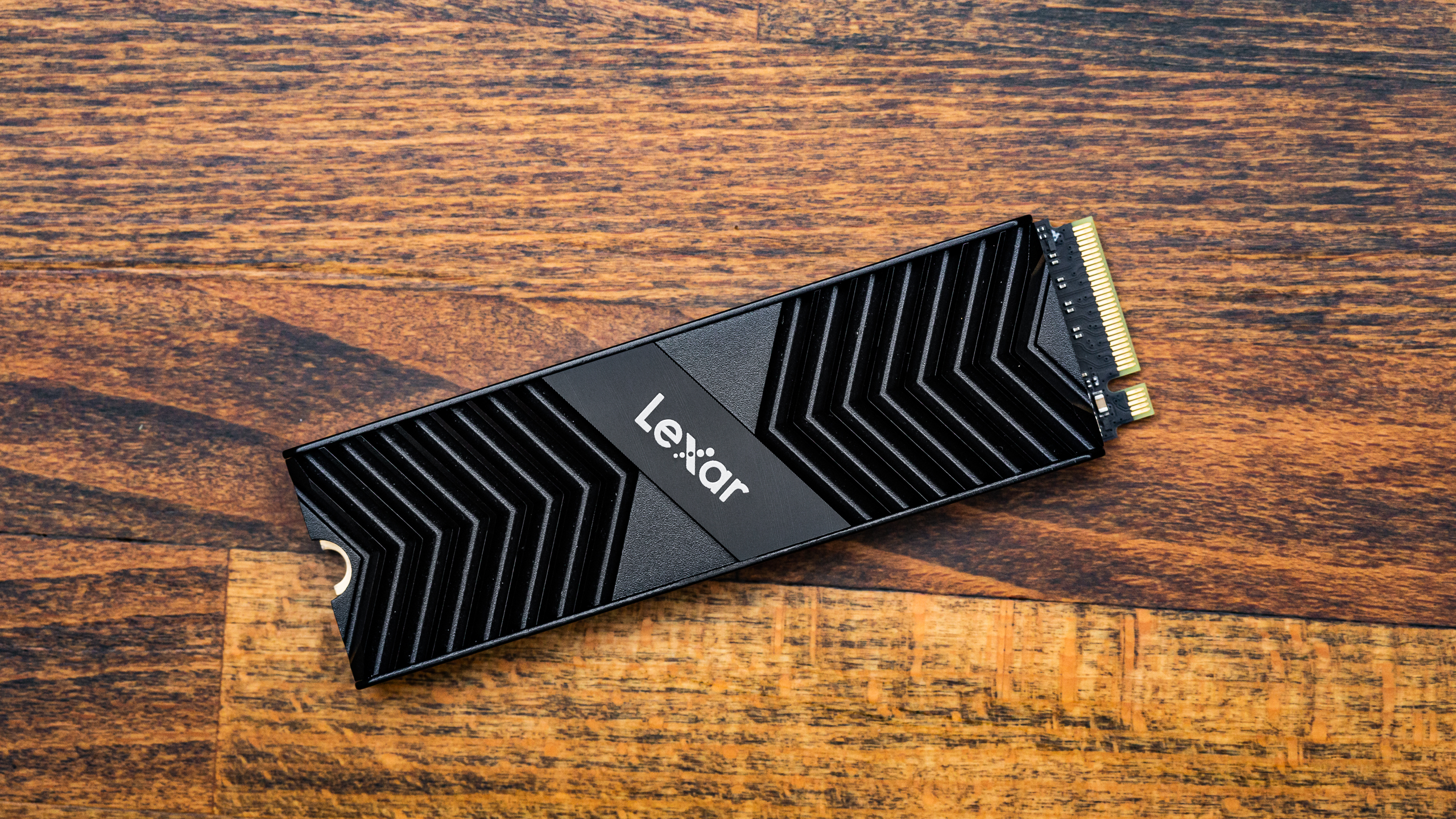
The Lexar Professional NM800 Pro is a high-end PCIe 4.0 NVMe SSDs that enters a crowded market but can set itself apart with its high efficiency and low temperatures. This drive is best caught on sale and particularly at 2TB, where it would be great for the PlayStation 5 or a gaming desktop. It sets no new performance records and has some inconsistent performance results, which keep it off the best PS5 SSDs and best SSDs overall lists, but on the whole it performs well enough to get the job done. With PCIe 5.0 SSDs on the horizon, this drive may best be suited to adding extra fast storage to your system.
SSD prices have been dropping fast for a while now so it’s important to score the right deal. This drive should be included in your list if the above characteristics fit your criteria. Another drive in this class that’s been priced low in recent sales is the Crucial P5 Plus, but the NM800 Pro is the superior choice as it generally performs better and comes with a stylish heatsink. The non-heatsinked version should be okay in a laptop if you really want full PCIe 4.0 bandwidth.
On the other hand, there are many drives faster than the NM800 Pro, even if the performance gap can be difficult to subjectively feel in the day-to-day. Our recommendation is to put this drive in your PS5 or as a secondary PC drive when it’s priced right, particularly at 2TB. The NM800 Pro does not really stand out in any other way.
The Lexar Professional NM800 Pro is available in 512GB, 1TB, and 2TB. The prices at the time of review are $69.99, $83.49, and $129.99, respectively. This pricing is competitive at 1TB and especially 2TB, but the market has been volatile. This is a drive that you might have to catch on sale, regardless of capacity.
The NM800 Pro can push PCIe 4.0 bandwidth at up to 7500/6500 MBps and 1300K/1200K IOPS for sequential/random reads and writes, respectively. Lexar warranties this drive for five years and 1PB of writes per TB capacity. This endurance rating is more than the industry average, although that is generally not a significant factor.
Software and Accessories for Lexar Professional NM800 Pro
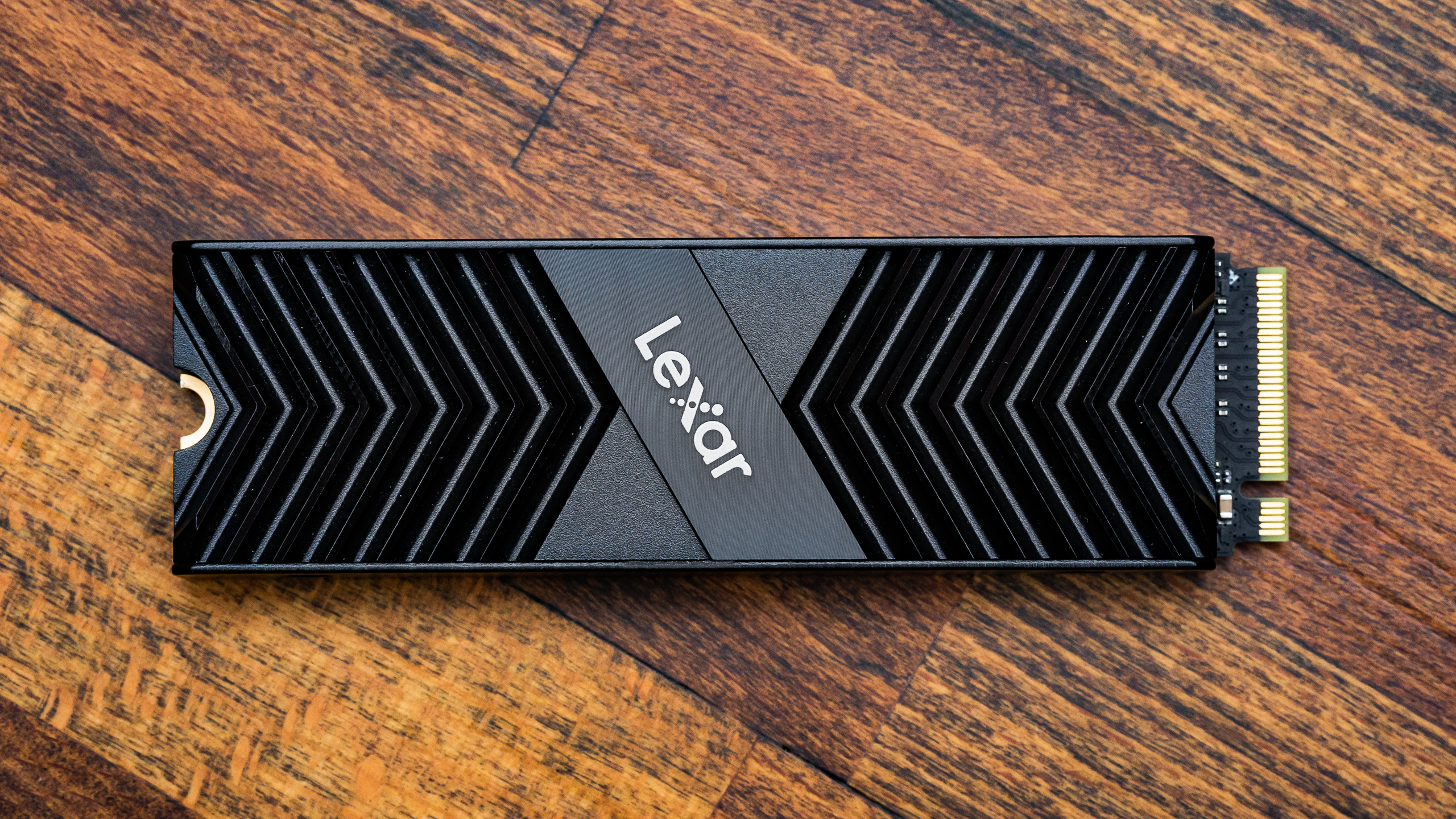
Lexar does not offer any special downloads or accessories for this drive, beyond the optional heatsink variant. We recommend Clonezilla or similar for imaging/cloning and CrystalDiskInfo for general health analysis.
A Closer Look at Lexar Professional NM800 Pro
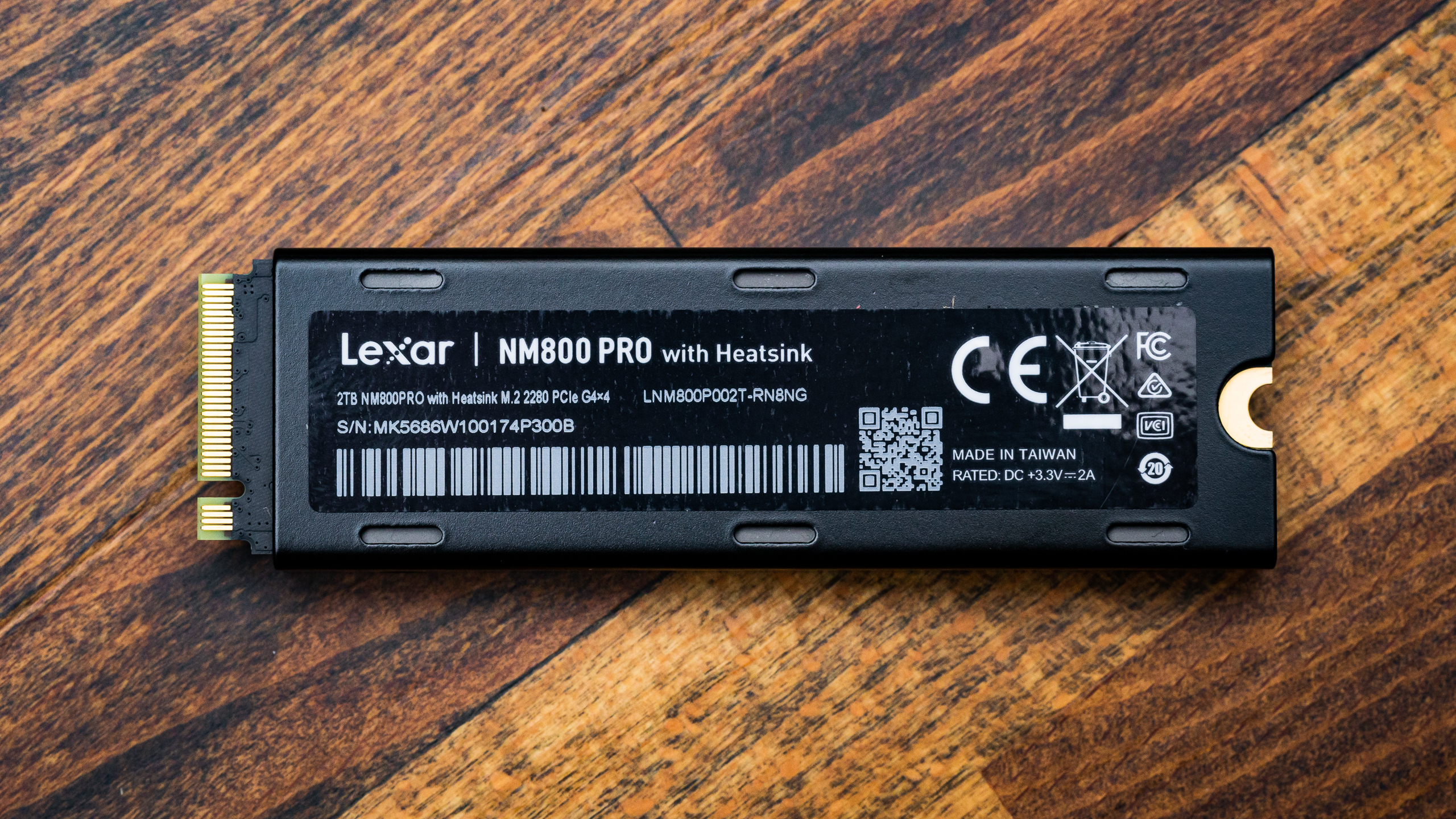
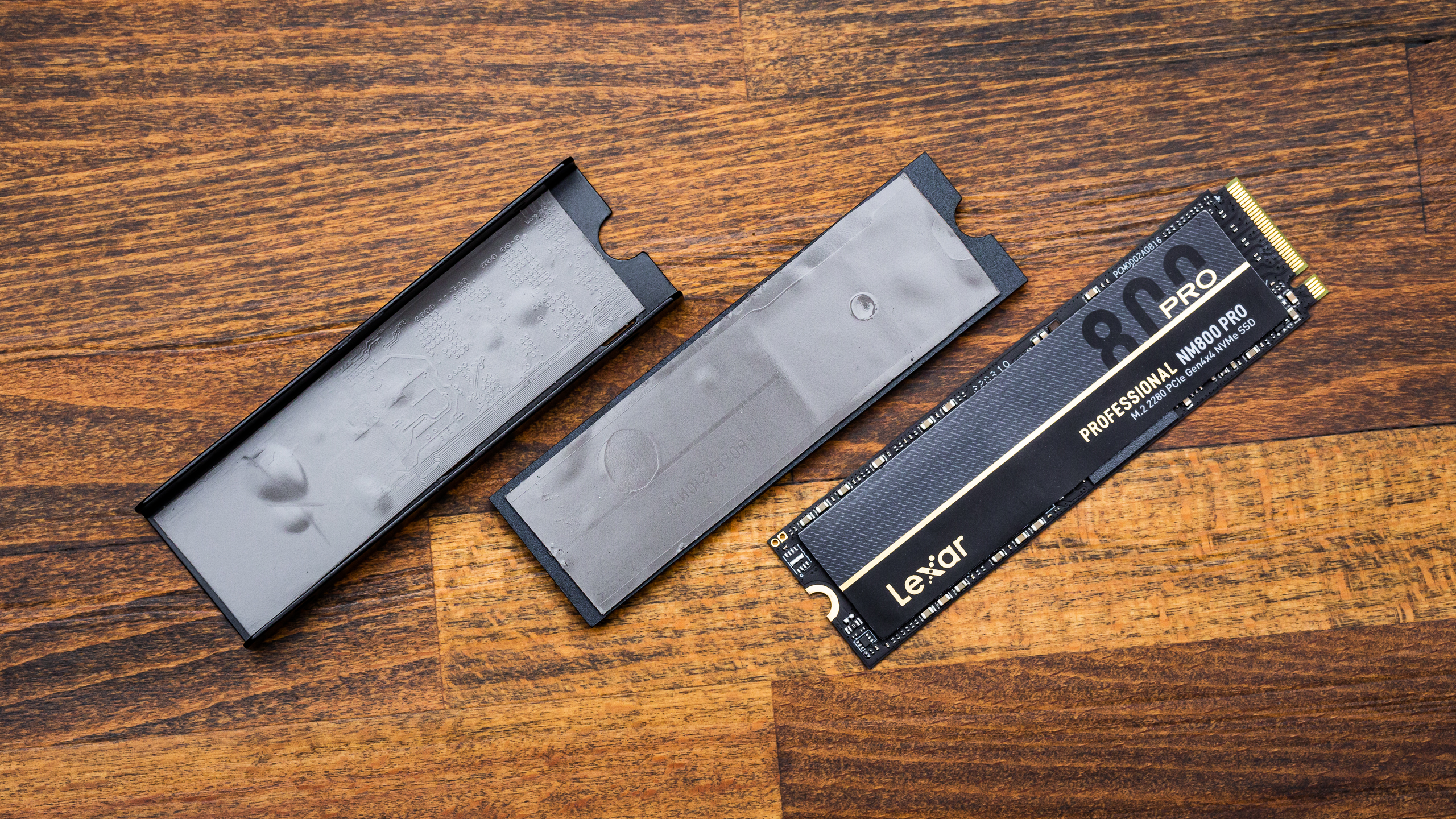
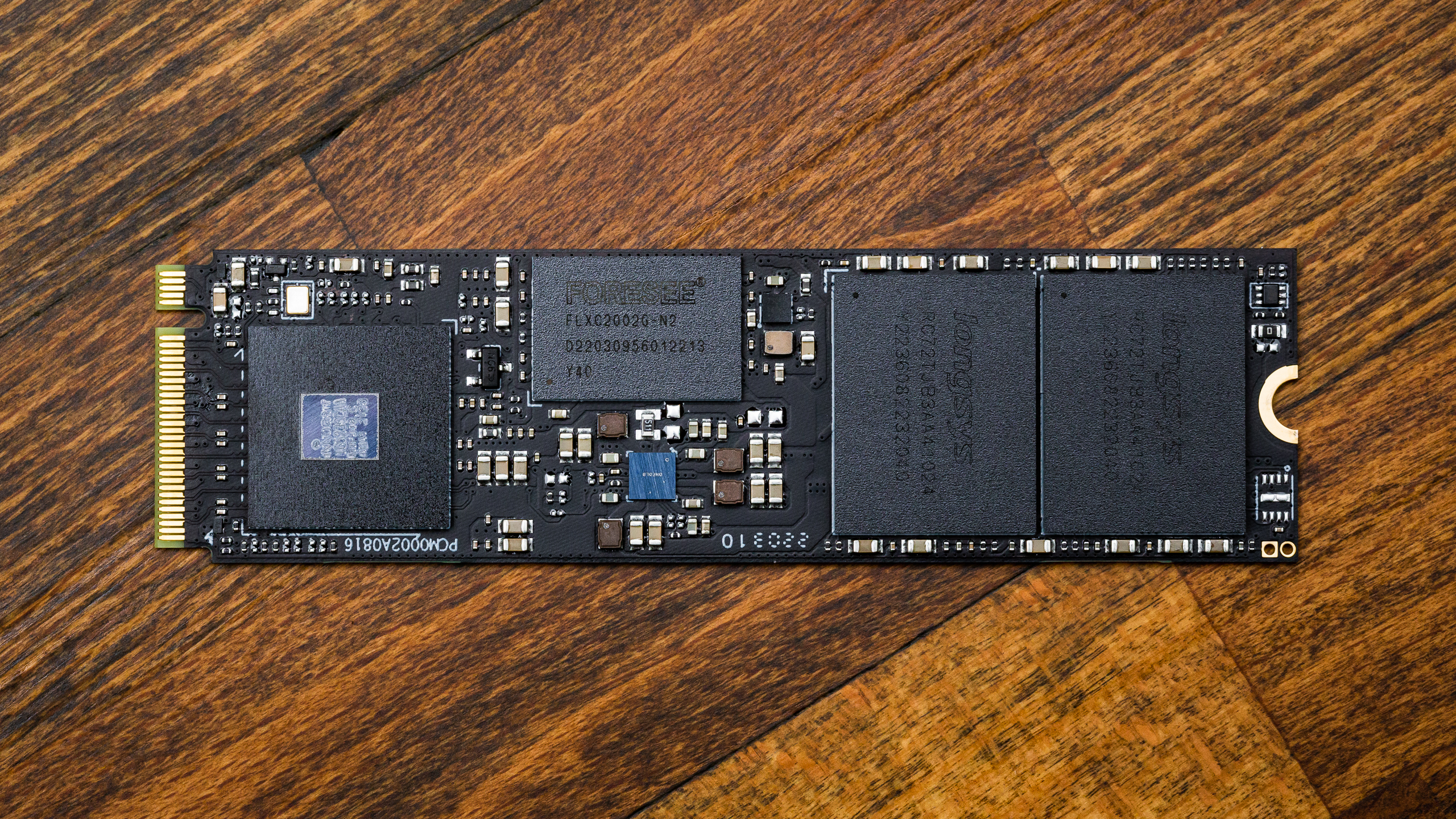


Our sample arrived with a heatsink, which is a nice addition. Some competing drives lack a heatsink which is beginning to be an issue with high-end drives that can experience thermal throttling without one. Lexar also sells a version of this drive without a heatsink. Either one would work fine for PlayStation 5 use. Underneath the heatsink, the drive is essentially identical to the non-heatsinked version.
Beneath the label, we spot a controller, a DRAM package, and two NAND packages. Even at 2TB this drive manages to be single-sided which is particularly challenging at this capacity. This makes it an option for certain tricky builds, including some laptops and HTPCs.
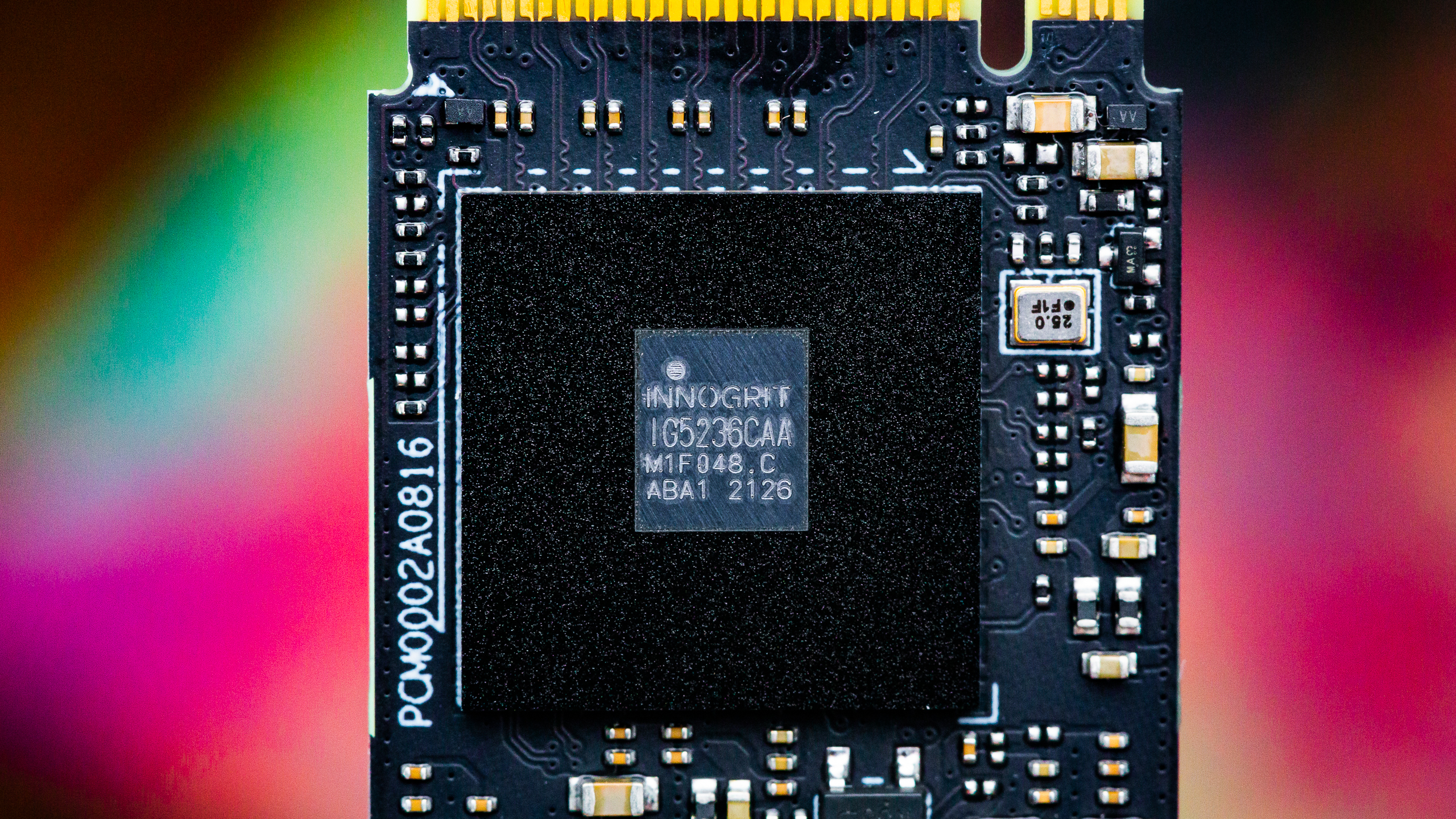

The controller is the InnoGrit IG5236, a popular 8-channel design that’s used for high-end PCIe 4.0 drives. Usually these drives are cheaper than competing SSDs built around Phison’s E18 or proprietary solutions. In the future it will have to tackle faster, 4-channel controllers that can max out the interface, such as the Maxio MAP1602 found on the Acer Predator GM7. Some other examples include the TenaFe TC2201 and SMI SM2268XT. These controllers are DRAM-less with fewer, faster channels, which makes them particularly competitive on price and for application in laptops.
The DRAM is labeled FLXC2002G-N2, which is LPDDR4X. This is extremely efficient DRAM, which should allow the NM800 Pro to run more efficiently as a whole, although DRAM is just one component. This will also help a little with thermal management, with or without a heatsink. This is 2GB of DRAM, which is an excellent amount for 2TB of flash.
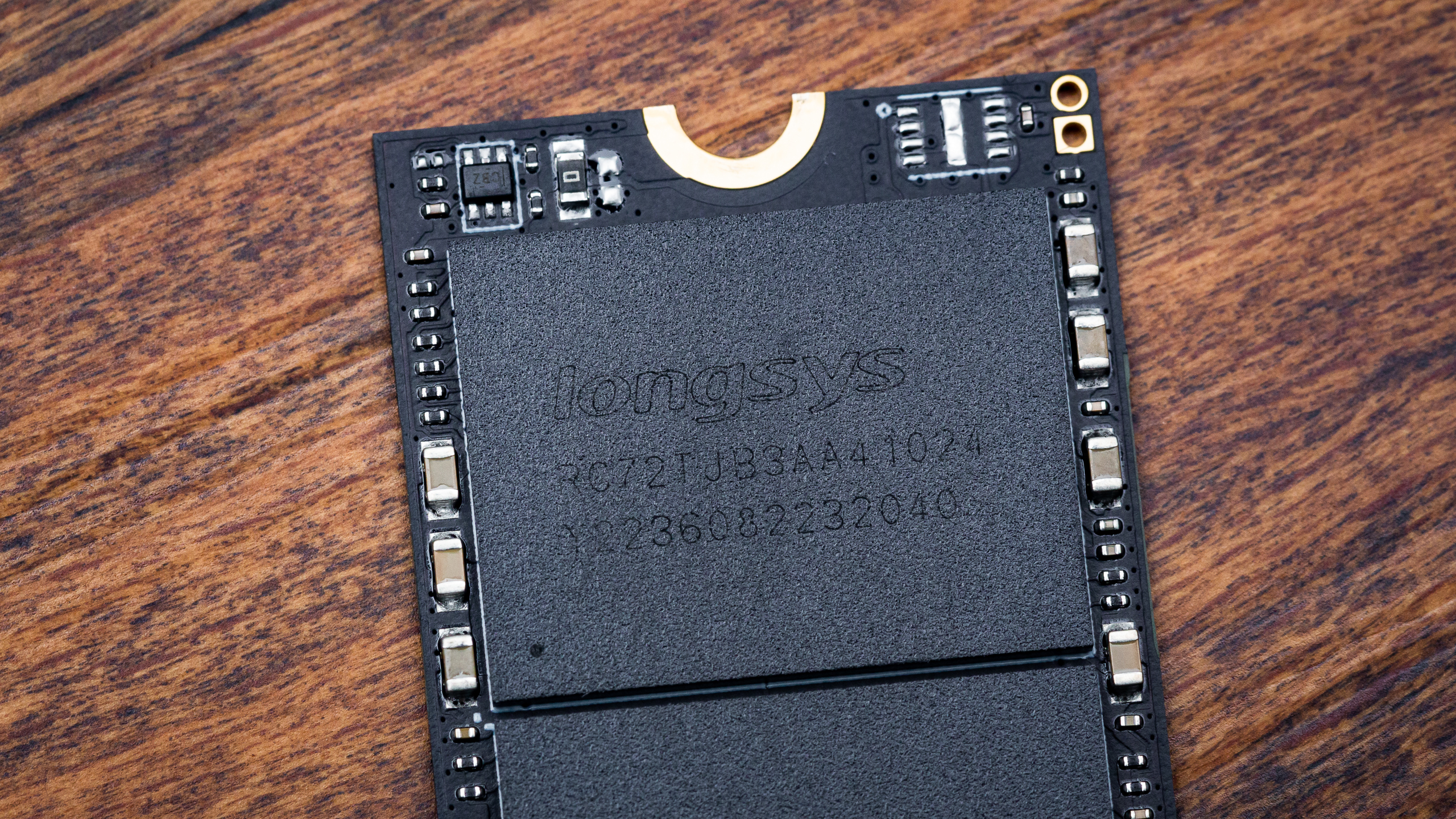
The NM800 Pro uses Micron’s 176-Layer TLC, or B47R. This flash is typically sold with 64GB dies which implies each 1TB NAND package contains 16 dies in a HDP or 16DP configuration. This is usually the most amount of dies one can reasonably stack per package.
Lexar has the option of swapping to other flash, such as the efficient YMTC TLC found on the Predator GM7, but reports are that the IG5236 SSD controller has firmware issues with YMTC flash. The efficiency of that flash would be a nice fit on this drive and it seems other flash manufacturers have taken notice of the possible advantages found with such a design.
MORE: Best SSDs
MORE: Best External SSDs and Hard Drives
MORE: How We Test HDDs And SSDs
MORE: All SSD Content
Comparison Products
We are putting the 2TB Lexar Professional NM800 Pro against some of the best drives we’ve reviewed, all high-end PCIe 4.0 options. This list includes the HP FX900 Pro, the Adata Legend 960, the Sabrent Rocket 4 Plus-G, the Solidigm P44 Pro, the Samsung 990 Pro, the WD Black SN850X, and the Acer Predator GM7000. The NM800 Pro is most similar to the FX900 Pro and Predator GM7000, which use the same controller and flash. Historically this combination performs well and can undercut the competition on price by a small amount. Phison, for its part on drives such as the Rocket 4 Plus-G, offers more flexibility to the manufacturer.
Trace Testing - 3DMark Storage Benchmark
Built for gamers, 3DMark’s Storage Benchmark focuses on real-world gaming performance. Each round in this benchmark stresses storage based on gaming activities including loading games, saving progress, installing game files, and recording gameplay video streams.

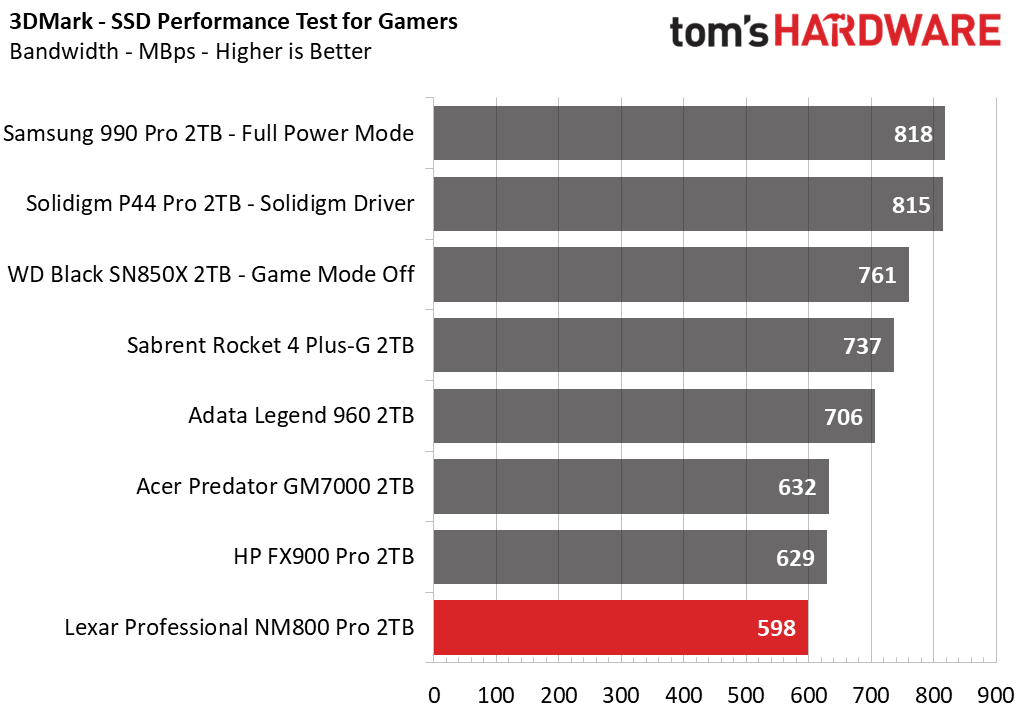
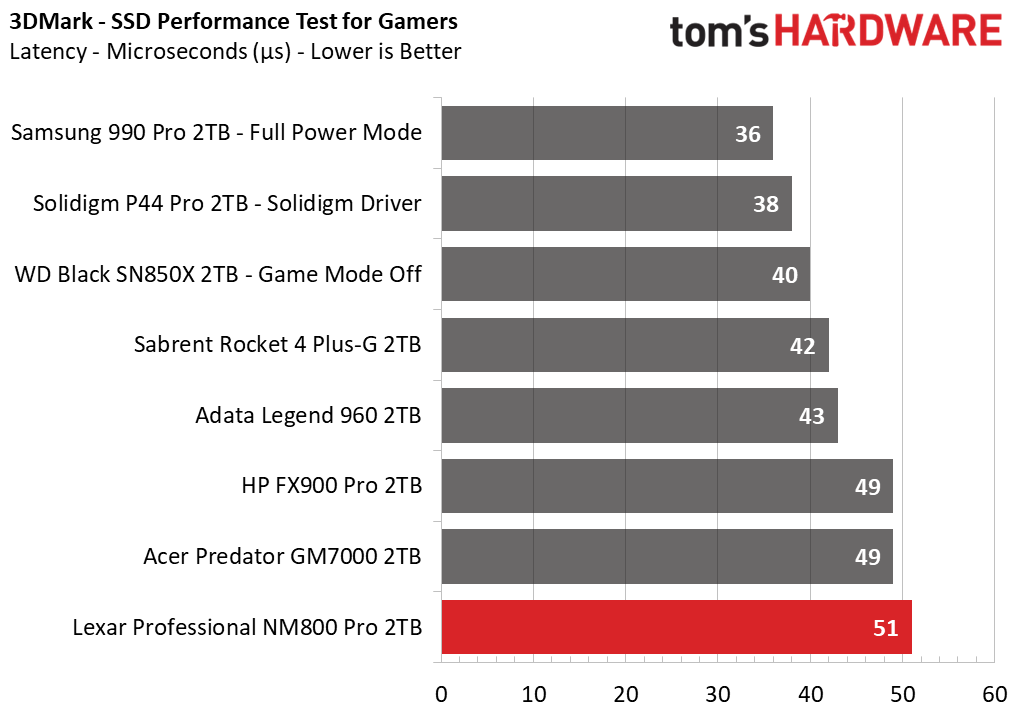
The NM800 Pro finishes dead last in 3DMark. It should perform at least on the level of the FX900 Pro and GM7000, but instead it falls short. This begins a pattern of sometimes inconsistent performance on this drive, possibly driven by firmware tuning.
Trace Testing – PCMark 10 Storage Benchmark
PCMark 10 is a trace-based benchmark that uses a wide-ranging set of real-world traces from popular applications and everyday tasks to measure the performance of storage devices.


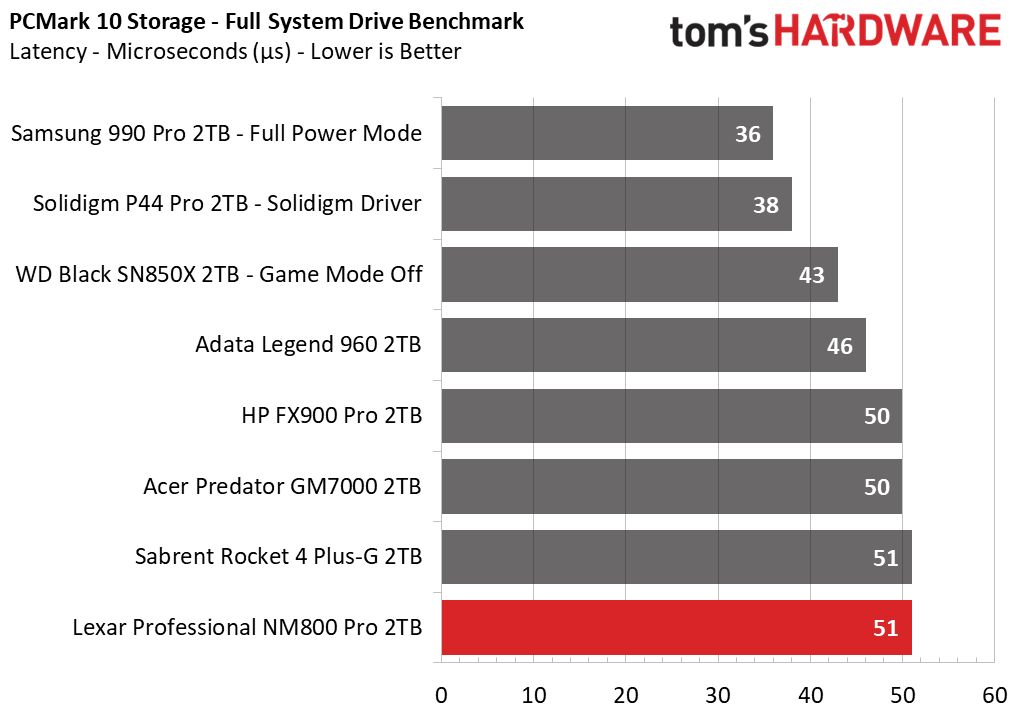
The picture looks a bit better in PCMark 10 as the NM800 Pro gets a middle-of-the-pack score. This is certainly good enough.
Transfer Rates – DiskBench
We use the DiskBench storage benchmarking tool to test file transfer performance with a custom, 50GB dataset. We copy 31,227 files of various types, such as pictures, PDFs, and videos to a new folder and then follow-up with a reading test of a newly-written 6.5GB zip file.

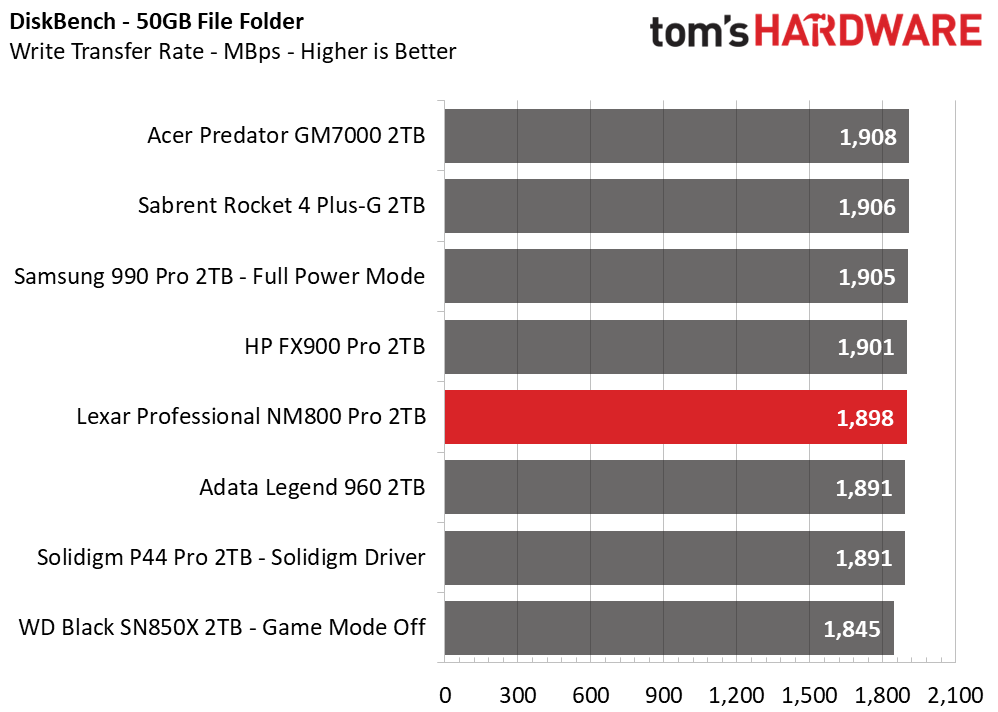
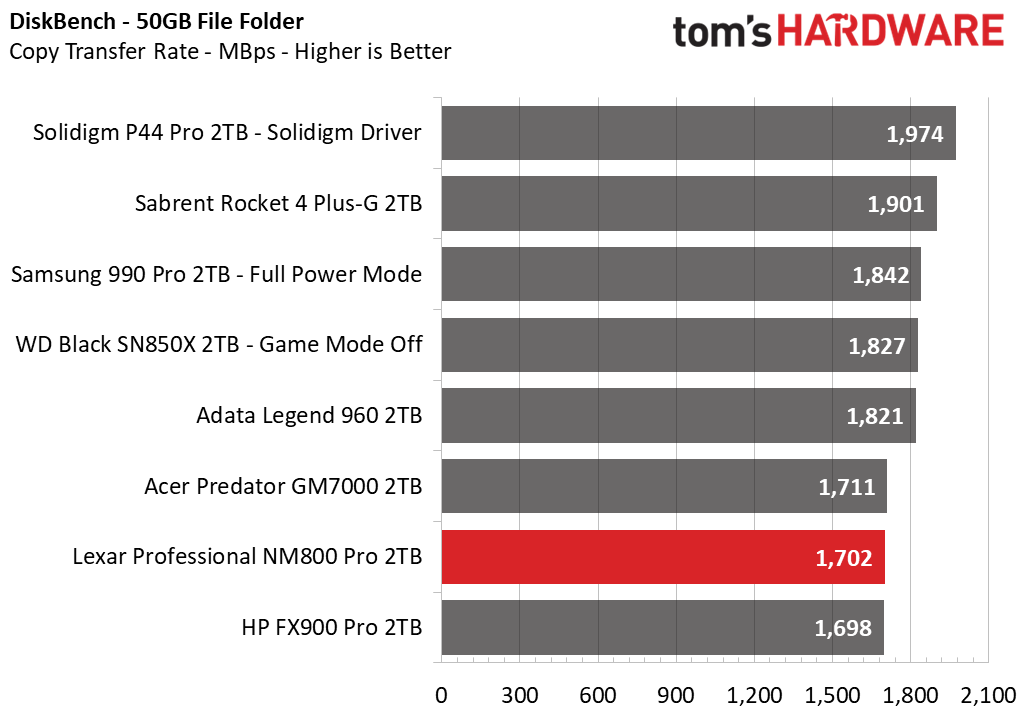
The NM800 Pro performs as expected in DiskBench, matching the FX900 Pro and GM7000. This is below other high-end PCIe 4.0 SSDs but is sufficiently fast.
Synthetic Testing - ATTO / CrystalDiskMark
ATTO and CrystalDiskMark (CDM) are free and easy-to-use storage benchmarking tools that SSD vendors commonly use to assign performance specifications to their products. Both of these tools give us insight into how each device handles different file sizes.
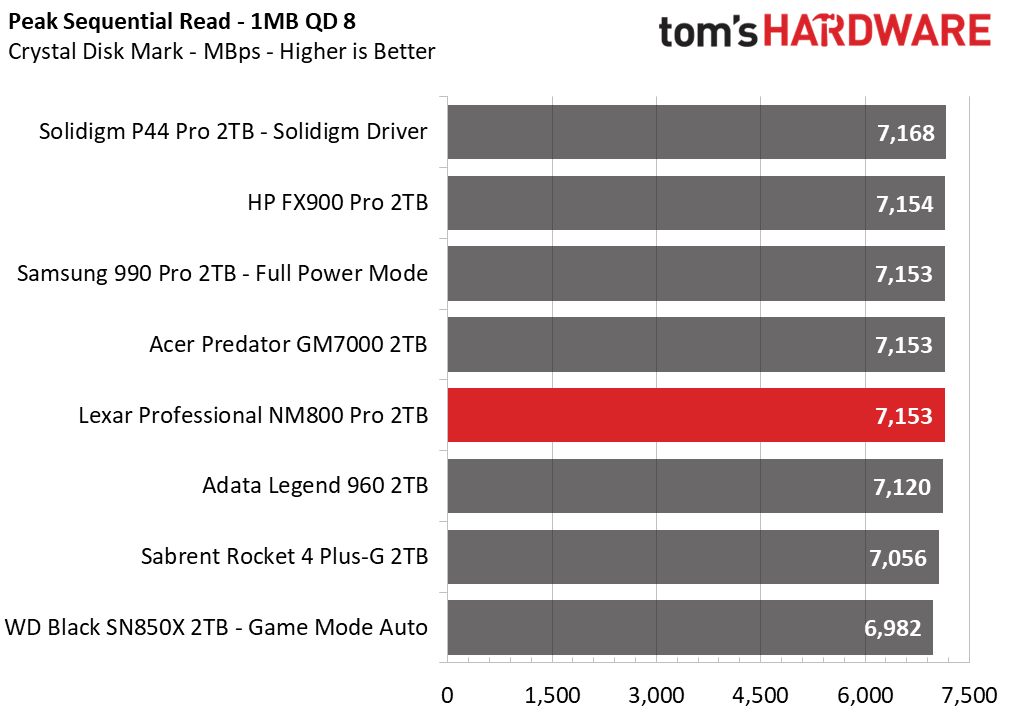
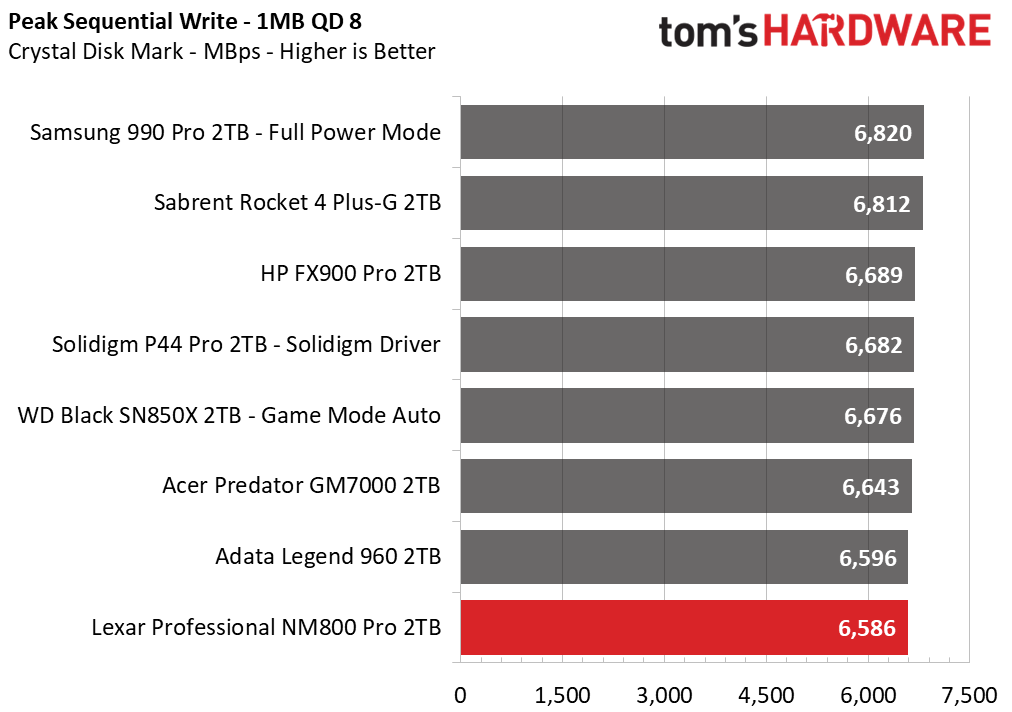


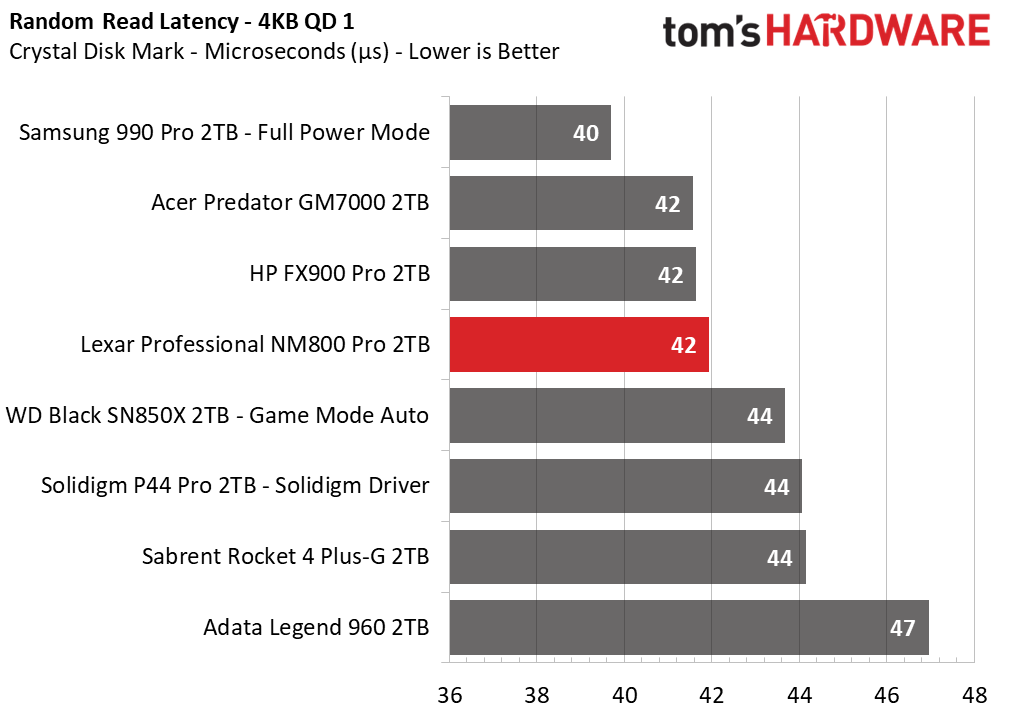
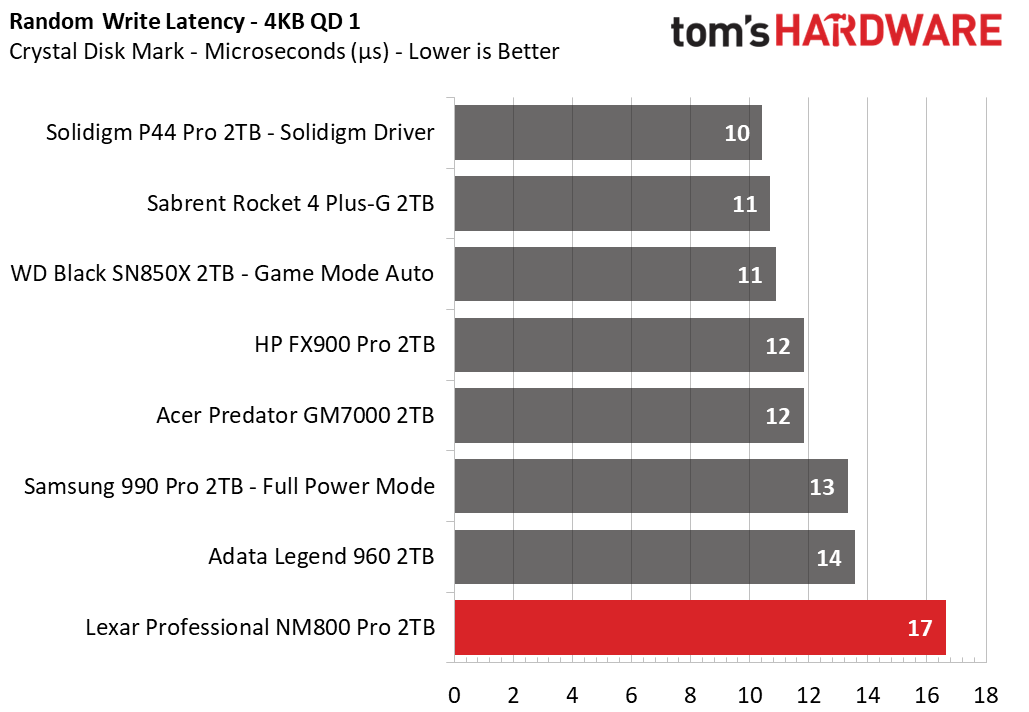


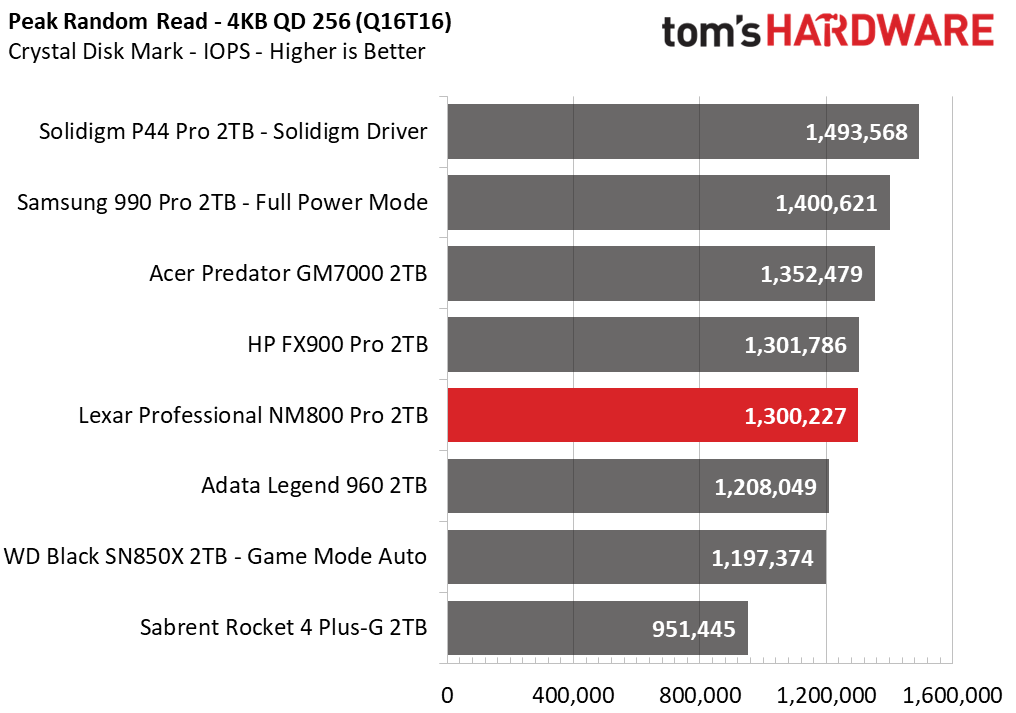
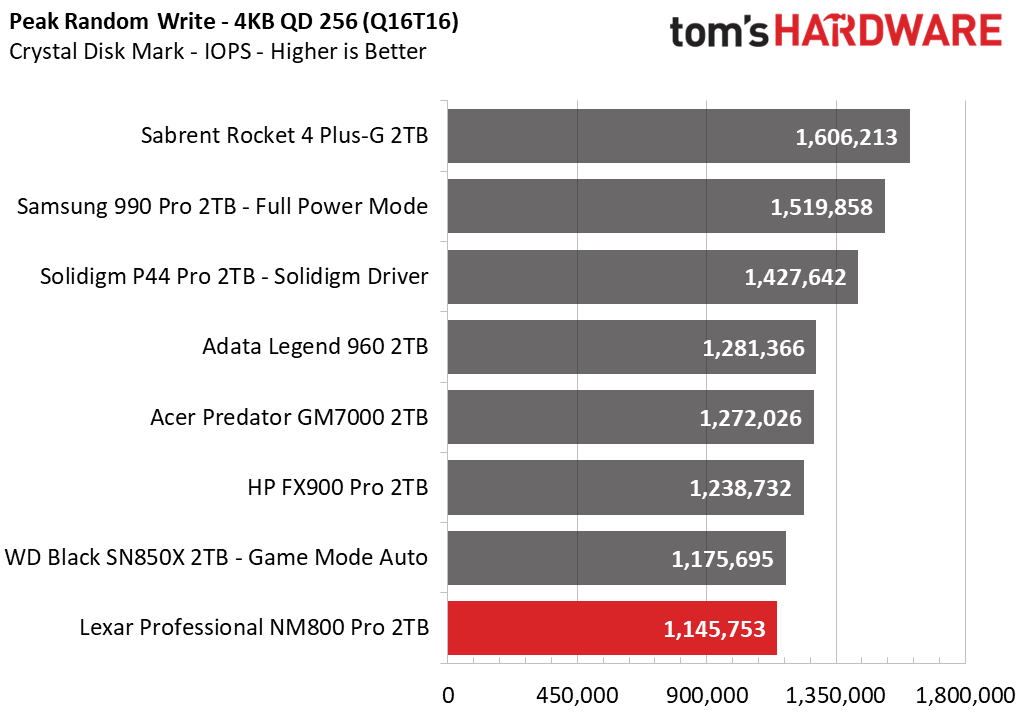
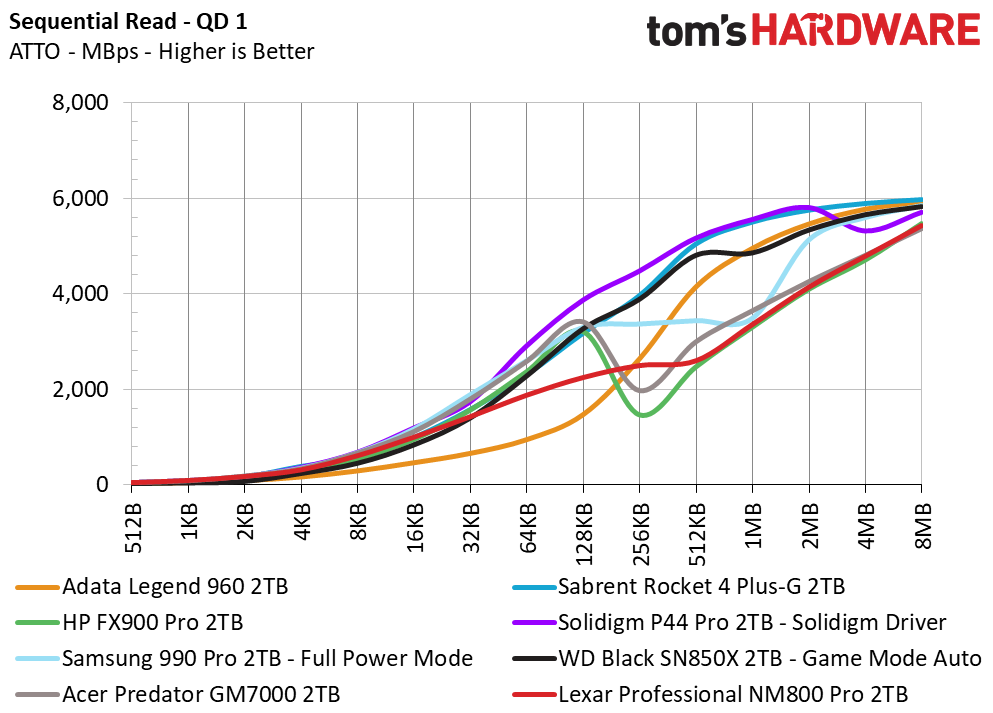
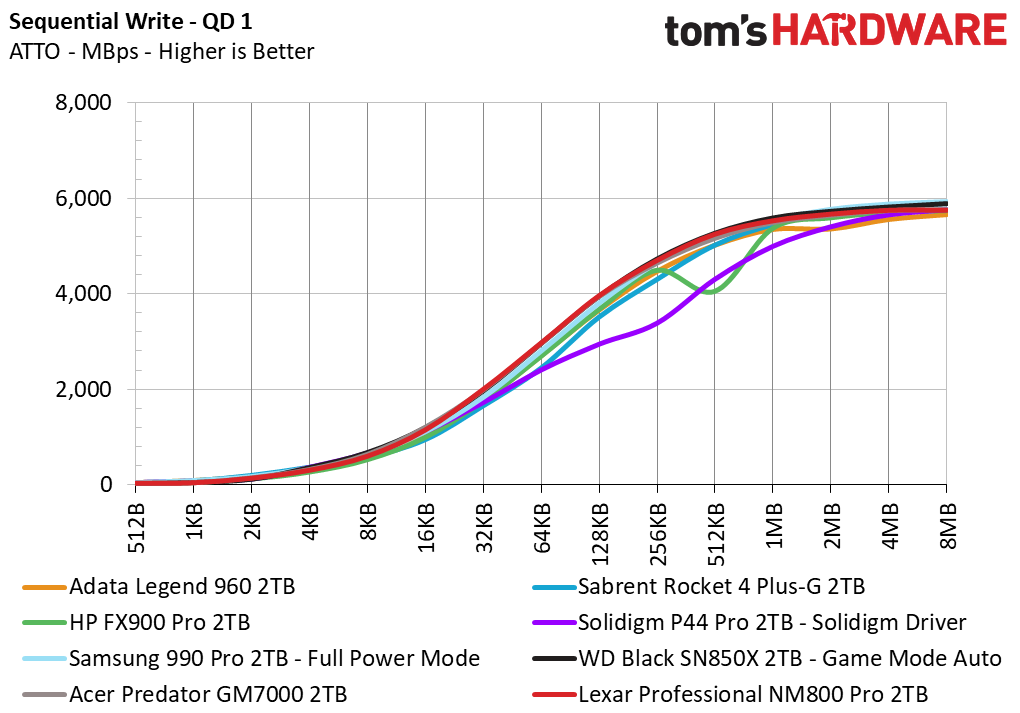
The NM800 Pro shows weak performance with sequential reads in both ATTO and CDM, matching the pattern of the FX900 Pro. This appears to be a facet of InnoGrit controllers, including the IG5220 which is used on the HP FX900. Sequential writes are satisfactory. Random performance in CDM is solid for reads, an important benchmark, but unusually poor for writes. This is more of the NM800 pro’s inconsistency.
There are many possible reasons for this, but it’s possible that Lexar’s choice of LPDDR4X for the DRAM cache and its firmware tuning creates this outcome. LPDDR4X is very efficient and typically bandwidth does not matter for DRAM’s application on SSDs. However, this DRAM has significantly higher latency, and DRAM is most useful for random writes on SSDs. Lexar appears to have optimized the NM800 Pro to run efficiently and at lower temperatures. This could be a worthwhile tradeoff for many applications.
Sustained Write Performance and Cache Recovery
Official write specifications are only part of the performance picture. Most SSDs implement a write cache, which is a fast area of (usually) pseudo-SLC programmed flash that absorbs incoming data. Sustained write speeds can suffer tremendously once the workload spills outside of the cache and into the "native" TLC or QLC flash.
We use Iometer to hammer the SSD with sequential writes for 15 minutes to measure both the size of the write cache and performance after the cache is saturated. We also monitor cache recovery via multiple idle rounds.
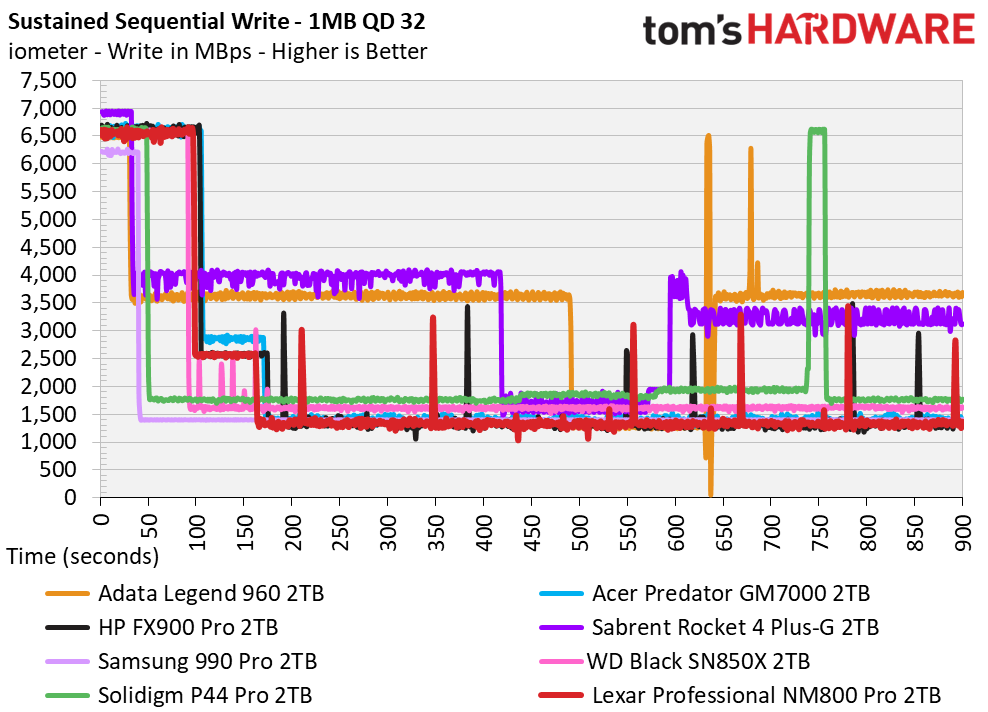
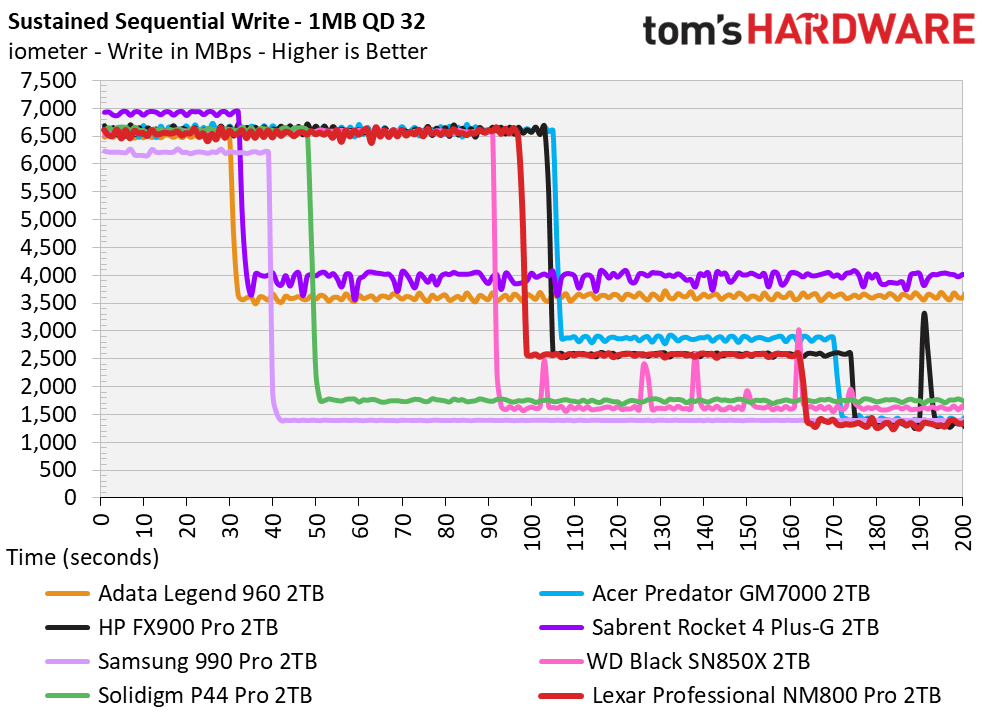
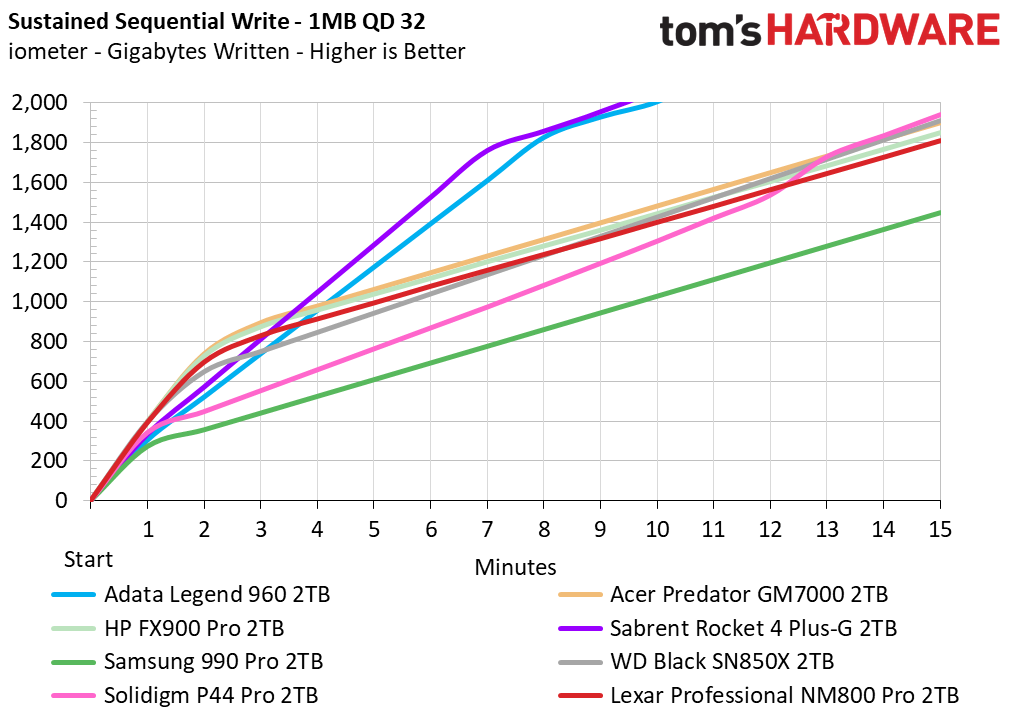

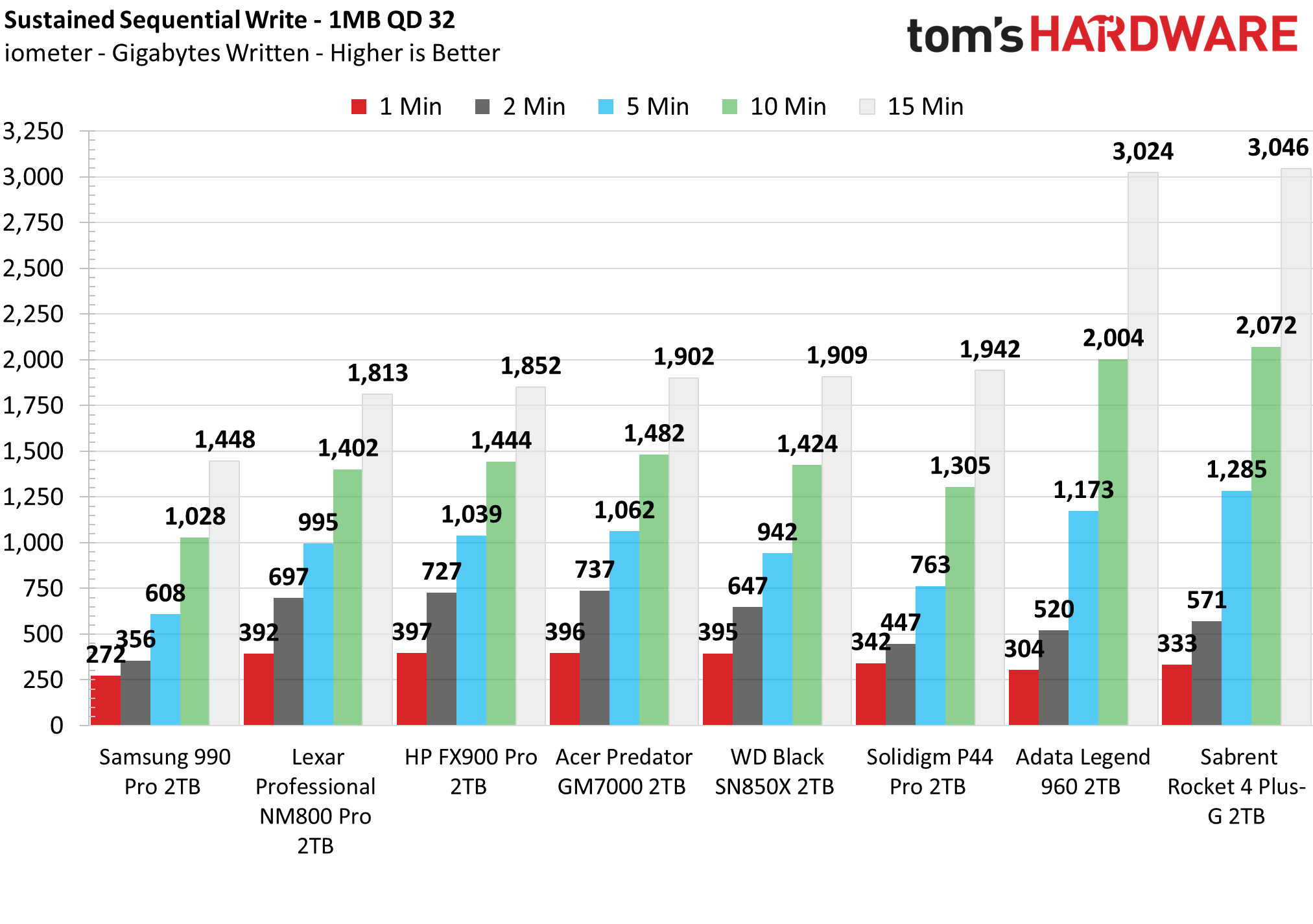
The 2TB NM800 Pro writes within pSLC at 6.55 GBps for over 97 seconds with a cache of 640GB. This is almost the entire drive in pSLC mode, making for a very large cache. TLC shows a write speed of 2.57 GBps for just over 64 seconds before the drive enters folding at 1.4 GBps. This is a good result and in line with the FX900 Pro and GM7000, with some minor differences. The drive is able to recover back to TLC mode without too much difficulty.
Power Consumption and Temperature
We use the Quarch HD Programmable Power Module to gain a deeper understanding of power characteristics. Idle power consumption is an important aspect to consider, especially if you're looking for a laptop upgrade as even the best ultrabooks can have mediocre storage.
Some SSDs can consume watts of power at idle while better-suited ones sip just milliwatts. Average workload power consumption and max consumption are two other aspects of power consumption, but performance-per-watt is more important. A drive might consume more power during any given workload, but accomplishing a task faster allows the drive to drop into an idle state more quickly, ultimately saving energy.
Temperatures are gauged at both idle and load states via sensor and an infrared thermometer. The typical ambient temperature is at 24C. The load state involves sustained writes at maximum speed with measurement ensuing if and until throttling is demonstrated to discover the equilibrium temperature.
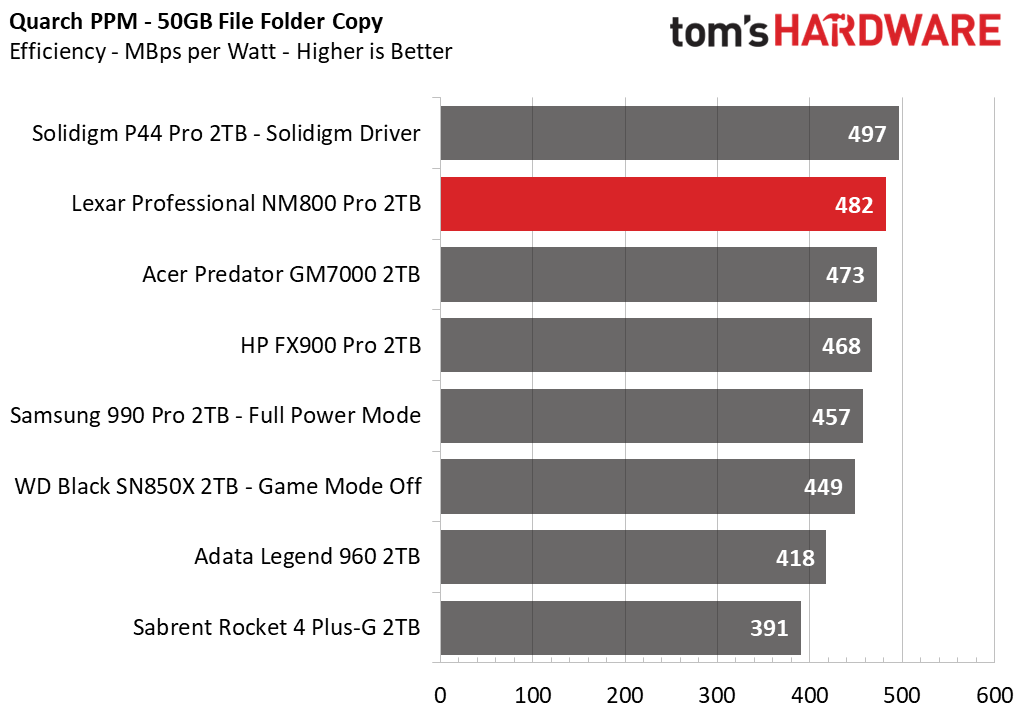
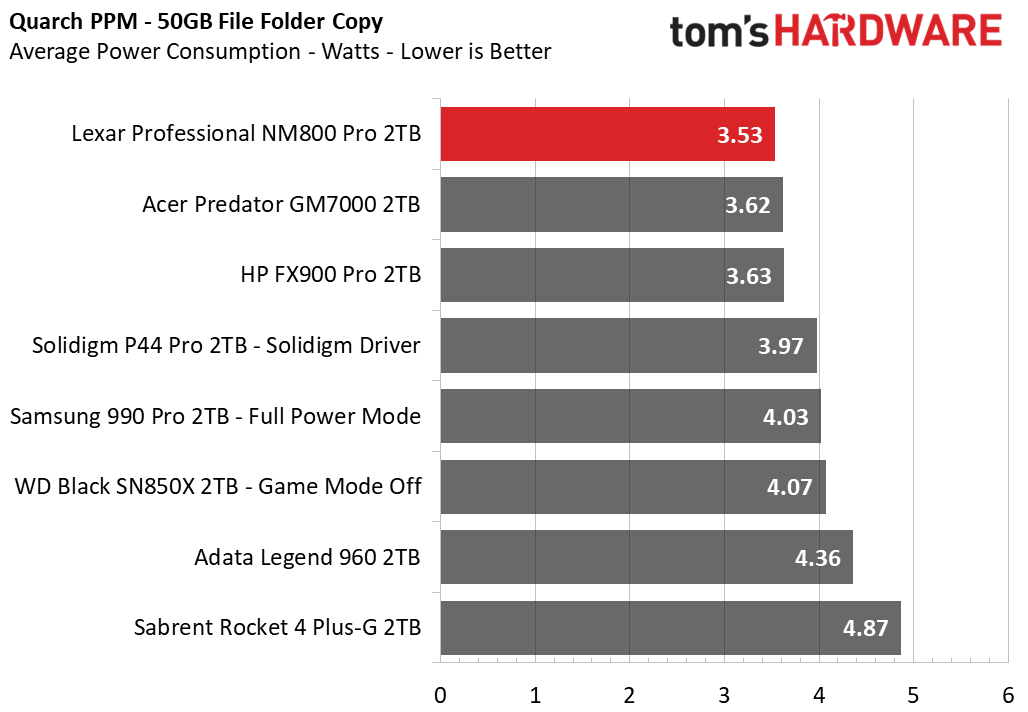
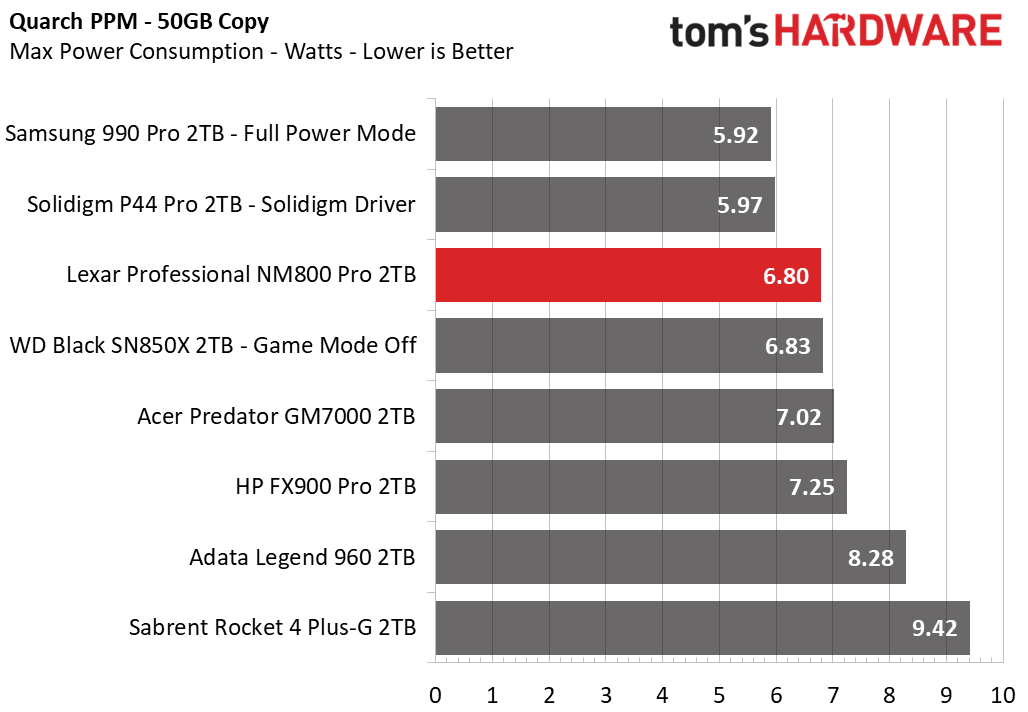
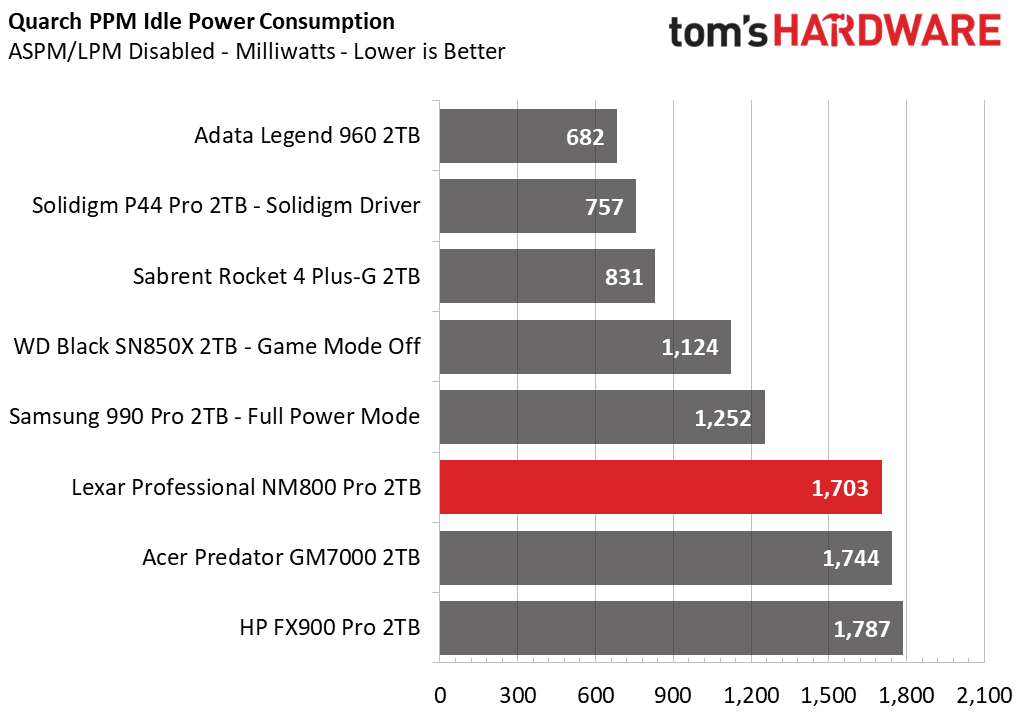
The NM800 Pro is quite efficient, which is nice. The included heatsink makes for an SSD that would work well in a PS5 or desktop environment. The non-heatsinked version would also be usable for reasons elaborated above, including for laptops.
The drive idled at a sensor reading of 34C which is a very cool temperature. Despite the large cache, the drive only reached 62C after 1TB of writes. This is an excellent result and the drive would operate well with any workload. It stays far cooler than the FX900 Pro with its graphene thermal pad, reinforcing our suspicions that Lexar designed the NM800 Pro to run efficiently and cool.
Test Bench and Testing Notes
We use an Alder Lake platform with most background applications such as indexing, windows updates, and anti-virus disabled in the OS to reduce run-to-run variability. Each SSD is prefilled to 50% capacity and tested as a secondary device. Unless noted, we use active cooling for all SSDs.
Conclusion
The Lexar Professional NM800 Pro is a typical high-end PCIe 4.0 SSD that manages to set itself apart in some ways without impressing on the whole. It runs incredibly cool and is very efficient but has inconsistent performance results. It’s placed in a difficult market which ultimately makes it an alternative choice whenever it appears on sale, especially attractive at 2TB. The heatsinked version would be good in a desktop or PS5 while the non-heatsinked version could work in a laptop, thanks to Lexar’s optimizations.
Compared to similar drives, like the HP FX900 Pro, the NM800 Pro is more efficient thanks to its single-sided design and the use of LPDDR4X. This also helps it run cooler as a whole, and a lot cooler with its heatsink. The drive cannot directly compete with the best but it doesn’t have to if it’s priced right. Lexar also gives a boost with the drive’s TBW rating, which would perhaps entice you over its direct rivals when all else is equal. We think the option of a heatsink is a better selling point, though.
The SSD market has been long trending downwards in terms of pricing which makes it challenging to make a wise purchase. It’s perhaps best just to look for the right deal and grab it. It’s better to focus on figuring out what you really need. The NM800 Pro is still viable in some cases. With PCIe 5.0 drives and new hardware coming in the near future, this SSD is probably an impulse buy for your PS5 or for extra storage on your main machine, and that’s okay. It’s just not something worthy of a high score.
MORE: Best SSDs
MORE: Best External SSDs and Hard Drives
MORE: How We Test HDDs And SSDs
MORE: All SSD Content







